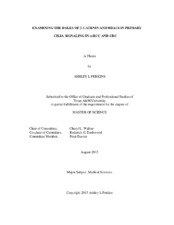| dc.description.abstract | Primary cilia are single hair-like organelles found on the apical surface of growth arrested and differentiated cells and can be found in almost every cell type, including epithelial cells, fibroblasts, olfactory neurons and photoreceptors, which reflect their diverse cellular functions. The primary cilium forms upon entry into G0; preceding G0 arrest, the cilium resorbs through mechanisms involving deacetylation of the tubulin by specific deacetylases. Functionally, the primary cilium acts as a mechanosenor, chemosensor and osmosensor for the cell, detecting its neighboring cells and responding to extracellular signals. Due to its versatility in functions, dysregulation of the primary cilia has been associated with multiple human diseases and syndromes termed “ciliopathies”, which include polycystic kidney and liver disease, primary ciliary dyskinesia, nephronophthisis and more recently, colon cancer.
Another primary cilia-related disorder is von Hippel-Lindau (VHL) disease is a systemic disorder predisposing patients to hemangioblastomas, phaeochromocytoma, and cysts in the kidney and pancreas. The loss of the VHL protein (pVHL) is the most common genetic mutation associated with clear cell renal cell carcinoma (ccRCC). Functionally, pVHL is an E3 ligase involved in targeting proteins, such as hypoxia inducible factor (HIF), epidermal growth factor (EGFR) and protein kinase Cγ (PKCγ) for proteasomal degradation and has been shown to be involved in microtubule stability and maintenance of the primary cilium; loss of pVHL is associated with loss of primary cilia. The mechanism by which pVHL regulates formation and function of the primary cilium is not fully understood but is of importance, especially in the setting of renal cell carcinoma (RCC).
Recent studies indicate that Aurora kinase-A (AURKA), a mitotic kinase, plays an important role in the resorption of primary cilia via interaction of human enhancer of filamentation 1 (HEF1) and activation of histone deacetylase 6 (HDAC6). Our studies show that in the absence of pVHL, AURKA is upregulated, leading to activation of HDAC6, shortening the primary cilia. Given that pVHL stabilizes Jade-1 to promote degradation of β-catenin, we investigated the role of β-catenin in transcriptionally maintaining AURKA levels. We found that in VHL-null cells, activated β-catenin translocates to the nucleus, increasing AURKA mRNA and protein levels. Using an inhibitor of β-catenin driven-transcription, iCRT14, we were able to rescue aberrant AURKA signaling and the ciliary defect in VHL deficient cells. Thus, our studies have identified a pathway that regulates primary cilia in the setting of RCC with two potential targets, for therapeutic intervention. Additionally, direct roles for primary cilia in colon tumorigenesis have yet to be studied in depth. The adenomatous polyposis coli (APC)/β-catenin Wnt signaling proteins, commonly dysregulated in colon cancer, have independently been localized to microtubules and are transported along the structures, via KIF3α. Additional evidence supports β-catenin being a crucial facilitator of ciliopathies. Here, we present evidence for a role of primary cilia in colon cancer, demonstrating how dysregulation of Wnt pathway proteins correlates with loss of primary cilia. Our data also provide support for similarities between the colon and kidney with regards to ciliary maintenance and the mechanisms involved. | en |


